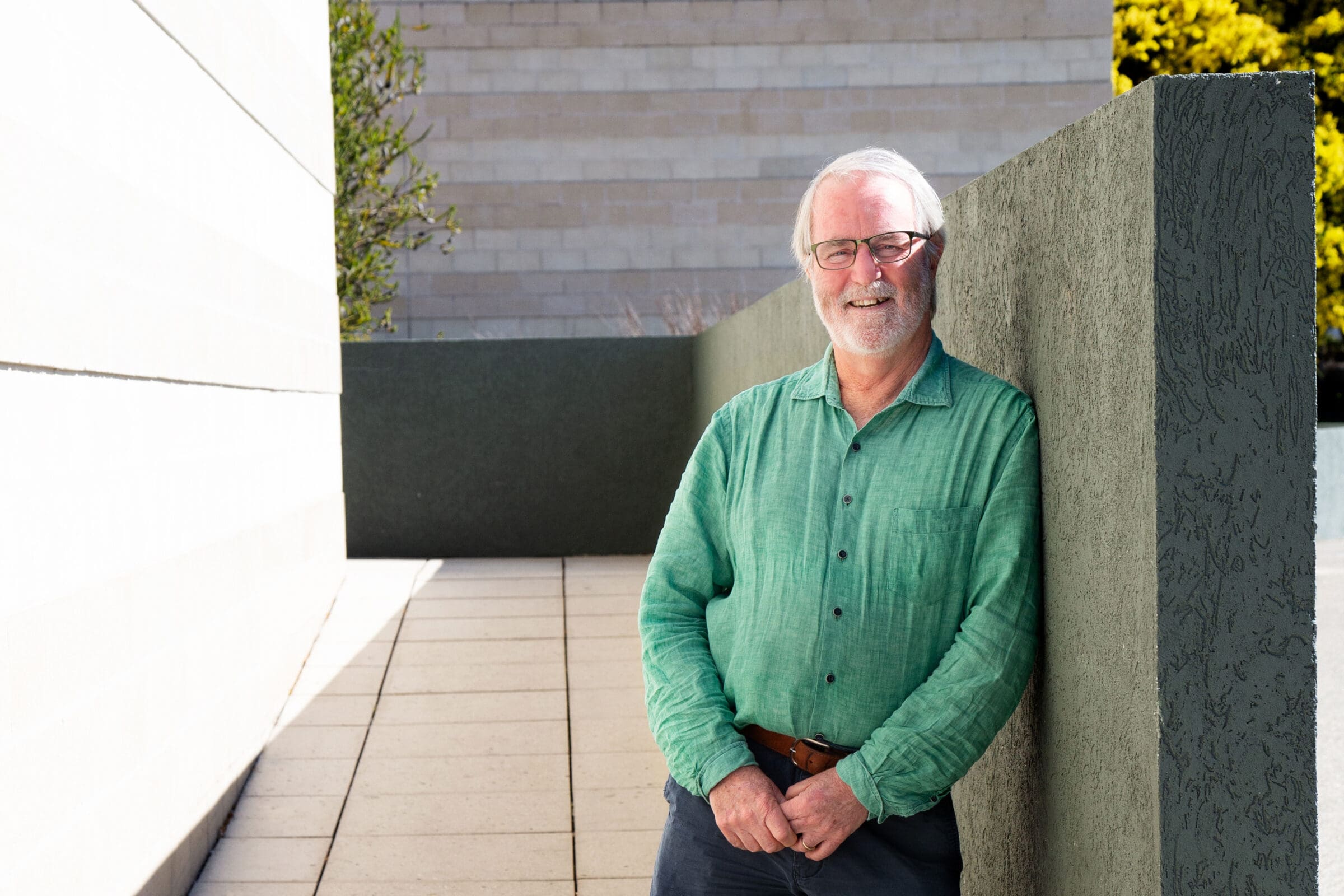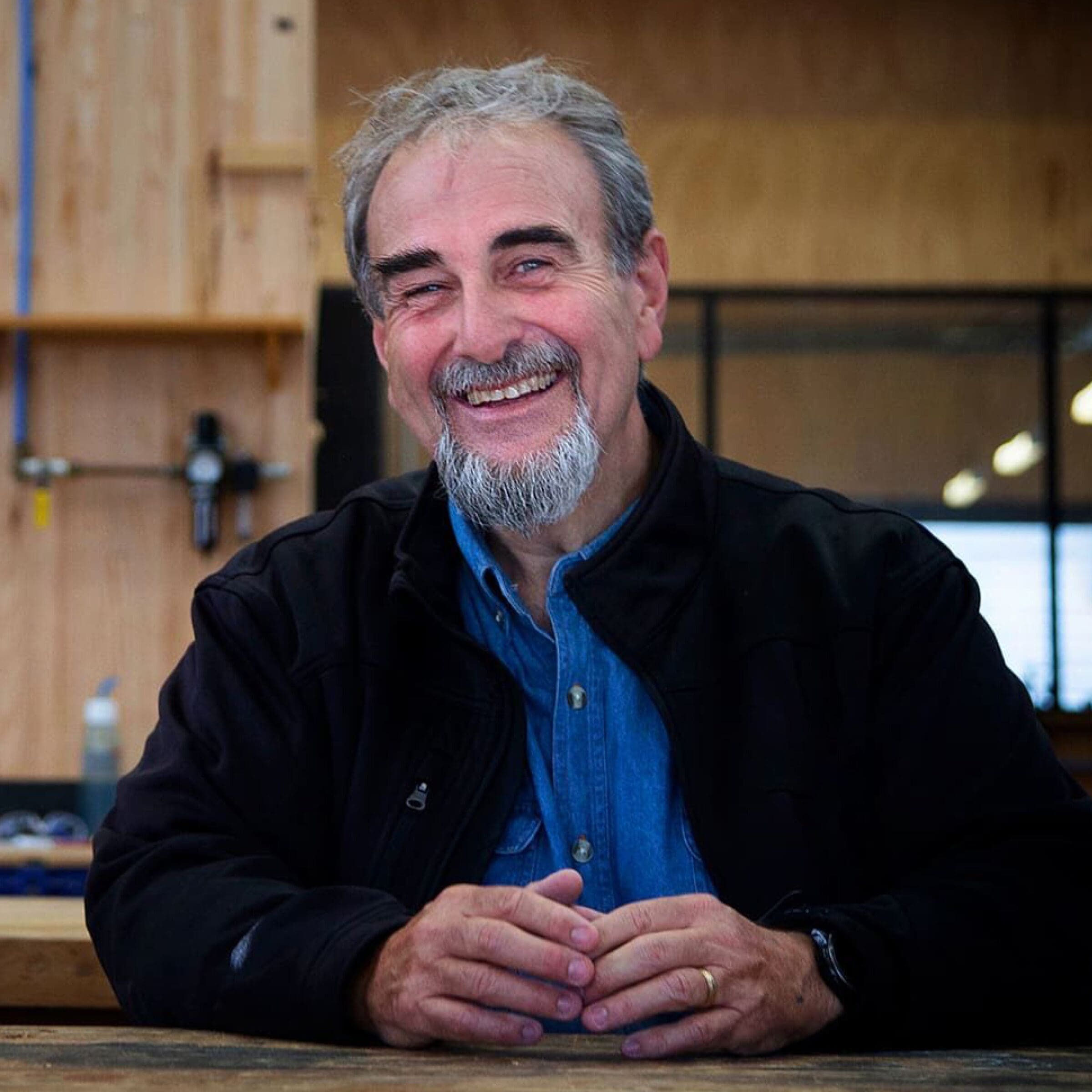Professor Greg Nolan, architect, researcher, problem solver and raconteur on the most asked questions about Tasmanian Timber.
Professor Greg Nolan arrived at the Original Thinkers podcast studio on his push bike, in his high visibility vest, a vest that has no doubt seen it’s share of building sites, sawmills and forestry coupes.
As part of this series on Tasmania’s timber supply chain, we needed a “Problem Solver”, a trusted expert that could speak to the questions most often asked by architects. As a beloved professor at the University of Tasmania’s School of Architect and Design and Director of the University’s Centre for Sustainable Architecture with Wood, Greg’s knowledge is unsurpassed.
The conversation started with Greg’s experience as an architect working in Australia and Internationally, and led to interesting discussions about the uniqueness of timber as a building material, how it’s moisture levels change to be in equilibrium with its environment, why specifiers need to understand their timber, quality assurance programs, old growth forests and why if an architect is interested in knowing more, they should just come to Tasmania and go and have a look.
These are excepts from that fascinating conversation. To hear more listen to the episode of the Original Thinkers Podcast here.
Timber is not like other building materials, timber has ‘terrior’
“There are materials that a building design professional like an architect or engineer will be trained in, and timber’s one which you’re not trained in very much,” explained Greg.
“The reason is because it has a level of complexity, which other materials don’t necessarily have. If we look at most of the major building materials we make stuff with like glass, steel, aluminium, or plastics, all of those materials are the result of a high energy engineering controlled process. So you take an ore, or a raw material like oil. You then transform that material from what it is to something different by applying lots of energy. As it’s an engineered process, you can control what comes out at the end. When we deal with steel or concrete, they’re exactly the same. Steel is an anonymous material, we don’t know where it’s come from, because it’s the same everywhere. German steel and American steel and Australian steel is pretty well interchangeable.”
“It’s the opposite with timber. What we’re doing with timber is we’re taking something that the tree has grown. It’s grown the wood to satisfy its purpose. It wants to stand up, it wants to grow tall, it wants to support the leaves. We then harvest the tree for a lot of wood products. All those basic characteristics that the tree determined by millions of years of genetics are still in that piece. We then will reduce the piece, we don’t transform it, we take a log and we cut it into smaller bits, and then we grade those bits, but each bit then is still part of a tree. It has terroir. It comes from a place. It comes from a tree. If we take something like radiata pine, radiata pine grown in Tassie will be different than radiata pine grown in South Australia or the Tumut region of New South Wales. They’ll have different densities, they’ll have different basic characteristics depending upon age and a range of other things. So even with the things that we think are standard, they’re not really standard.”
With steel, you can order a piece of mild steel and know what you’re getting. You can order a piece of wood, but which bit do you want? Do you want Balsa, which has got a density of about 150 kilograms a cubic metre. Or do you want Darwin Woolly Butt, which has got a density of about 900 kilograms a cubic metre? They’re both bits of wood.
“So you need an additional layer of knowledge and consideration when you’re using timber, which you don’t need when you’re using steel and concrete.”
Moisture and the hygroscopic nature of timber
“The fundamental thing is that wood is a natural material. It comes out of the trees and it is hygroscopic, which means it gives in and takes off moisture to be in equilibrium with the surrounding environment,” explains Greg.
“And when it does so the wood matrix changes its size. So, as the water goes in, the piece gets a little bit bigger, and as the water goes out it gets a little bit smaller. We know that happens, and timber researchers know the ratios by which it occurs for most species.”
There are still general boundaries upon which you quite easily design something. There’s a whole series of really well-structured Wood Solutions design guides that cover a whole range of different topics
“In the late 1990s, there was a very, very big job done in Melbourne for a sports arena. And something like seven or eight semi trailer loads of flooring went into this job. The people who specified it really knew what they were doing. They specified the timber to be at 8 percent moisture content, which at that stage, and still is, outside of the standard. It’s less than the standard. They only used a 65mm wide board (small boards). With many small boards, any movement [will effect the] small gaps rather than any single big gap. And then they combine the air conditions below the floor with above. Now that floor has been in operation now for 25 years without a problem.”
“There might be one down the road that was put in a year and a half ago and has been buggered up ever since.”
As a professional, it’s your responsibility to know the sorts of things that can go wrong and avoid them, particularly if it’s a big and important project. There is also the Expert Timber helpline, we can help.
Old Growth Logging
“We have to put this in a little bit of perspective,” Says Greg “The term old growth is a forestry term. It defines a type of forest. It doesn’t define a type of tree… The thing about an old growth forest, and I don’t have the exact words, but the definition is something like it’s a forest in which there is no perceivable evidence of human interaction.”
“…That implies that it is a forest of at least 100, 120, 130 years old, something of that order. It really takes a skilled forester to be able to make that definition. I can’t do it. The thing is people will see a big tree and say, that’s old growth. That’s nonsense. We’re in Hobart and there’s all these lovely trees on the approach to Mount Wellington. Some of them are quite big. The thing that people don’t realize is that every living thing on Mount Wellington was burnt to the ground in 1967. So every tree that’s on Mount Wellington is from 1967. That puts everything up there at about 57 years old. It’s all reserved, it’s a forest that has been reserved for other purposes besides its age.”
Tall trees are usually old ones, and the old ones may be in a forest that has been untouched, or they may be in a forest that’s been regularly used, and it’s just that tree has never been harvested before. In Tasmania the amount of material that comes from forests that could be defined as old growth are very small. I don’t know the figures, but almost all of anything that could be classed as old growth is in reserves now.
“The interesting thing is we can, if we want, get in the car and go and see. There’s a whole range of things we can’t check in life, but if we’re really concerned [about harvesting timber in Tasmania] we can go and look, and it’ll only take us a day.”
To enjoy the rest of Greg’s insights listen to his Problem Solving episode of the Original Thinkers Podcast Supply Chain Series here.
Links to the Wood Solution Guidelines can be found here.
The Expert Timber Helpline is available to answer your questions about Tasmanian timber. Call 1300 041 766.














